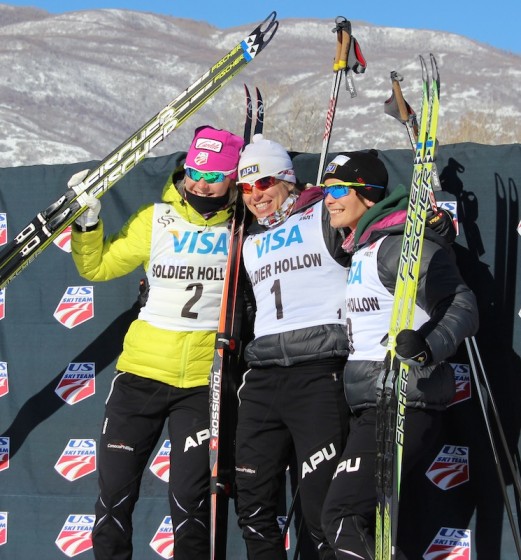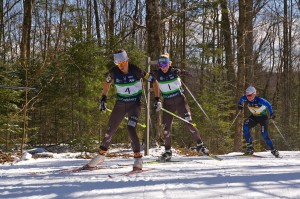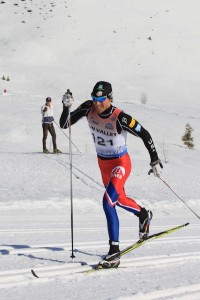
In an interview with a Norwegian television channel last week, Petter Northug, Jr. admitted to faking illness in 2011 to get out of racing at Norwegian Nationals (NM) prior to the Oslo World Championships. Norwegian national team members are contractually obligated to make an appearance at NM every year, and Northug dropped a bomb on the Norwegian sports pages by saying he skipped it and fabricated an excuse to do so. For the record, he went on to win three World Championship gold medals for Norway in front of a gigantic home crowd at Holmenkollen.

“I felt pushed ahead of World Championships in Oslo,” Northug said. “I wanted to go to NM; I wanted to take the championship gold. Then it hit me that I had gone to the Tour de Ski, [too]. I thought, ‘Be [tired] and get [sick] now, and you’re home exercising by yourself. Stay away from people when you say that you are sick to the media, and then you start working on what is important, what you will experience once in a lifetime.’”
The revelation that golden-boy Northug lied to get out of showing up at one of the biggest events in Norway sparked vigorous debate throughout the country last week. At the heart of the discussion was a question of whether Norwegian Nationals should be positioned to suit Norway’s World Cup team.
John Northug, Petter’s father and manager, suggested NM be moved to another time of year, to avoid conflicts for athletes who have big races like Worlds or the Olympics to focus on. NM might be better split into two parts in mid-winter and the spring, he said, so that World Cup athletes can still compete for a national title when they’re no longer concerned with major international championships.
Norwegian Ski Federation (NSF) cross-country committee director Torbjørn Skogstad responded on Saturday with the statement that the organization will not reschedule NM in 2014, an Olympic year. He cited impracticality in moving the national event for only a few national team athletes.
“The National Championship is in many ways an institution and an important meeting place for the entire ski Norway,” Skogstad said on the NSF website. “National Championship this year may not account for all national team [skiers], but is definitely the highlight for the rest of the senior athletes… We should be very careful not to upset the status of the National Championship today.”
The Federation’s relationship with NRK, the national TV station that has broadcasting rights to NM, dictates a certain order of events: first Nationals, then World Championships or the Olympics.
“Any relocation of the National Championship or changing the program of events requires political treatment,” the NSF press release explained.
The debate should sound familiar to Americans. Though the U.S. doesn’t have to consider TV rights when it schedules nationals, a more complex logistical dilemma has arisen in recent years: how to time the championship so that national team athletes can compete, but also give officials a single major in-season event from which to pick junior, U23, world championship and Olympic teams.
Kikkan Randall, Andy Newell & Co. haven’t raced at U.S. Nationals in years — as the U.S. Ski Team has become more competitive internationally, more of its athletes have chosen to remain in Europe for most of the season, either for the Tour de Ski or in-season training. Is U.S. Nationals still a true championship without them? And if it’s not, does that warrant a change?
The cross-country committee at the U.S. Ski Association (USSA) is currently considering the question. Coaches from around the nation discussed the issue at the annual congress last spring and formed a sub-committee to present possible solutions this May. USSA Nordic Manager Joey Caterinichio says that, depending on what this group finds, the governing body is open to the possibility of moving nationals to the spring.
“We’re not in Europe,” Caterinichio said a few days after nationals concluded in Soldier Hollow in January. “This year, it worked out pretty well to get our fastest skiers where they’re supposed to be, head to head, and still have a super quality event. We’ll definitely continue to look, moving forward, if that’s the best for the U.S.”
Currently, the U.S. technically splits its championship races between the winter and spring. U.S. Nationals are every January, with two sprints and two shorter distance races, and then 30/50 k Nationals take place in April as part of SuperTour Finals. Likewise, Canada hosts its championships after the World Cup season ends, before SuperTour Finals, and holds separate trials in January to pick athletes for its international teams. Typically, U.S. and Canadian national teams have participated in their spring championships after returning from Europe, keeping event visibility high and race organizers happy.
Some still don’t think the system is perfect. In the U.S., the January event still calls itself a national championship even though these days, the best American skiers are in Europe. Titles are on the line, and SuperTour points and prize money is doubled. But at the end of the week, those titles aren’t always in the hands of the country’s best skiers, leaving room for dispute when it comes time to name world championship teams.
The complexity of the scheduling problem is still relatively new. As Americans have improved their standing on the World Cup in recent years, greater numbers of World Cup team members have decided to skip Nationals and remain Europe to compete in the Tour de Ski—an event that itself is only seven years old. Simi Hamilton and Ida Sargent, who were not on the 2013 Tour roster, still skipped Nationals in order to fly back to Europe directly after the holidays, readjust to the time zone and train for the races that are important to them.

By most accounts, that’s a good position to be in. Randall, for example, last competed at Nationals in 2010. Now that she’s among the best skiers in the world, she has bigger things on her plate than affirming her position as top dog in the U.S.
On the surface, the primary purpose of a national championship is to award meaningful national titles. If that were truly the only point of the event, the problem would have an easy fix: push the whole thing to the spring, in place of SuperTour Finals. It’s the simplest way to allow the U.S. Ski Team’s athletes to compete for titles, if they want to. Junior/U23 World Championship teams would be named from a January Trials, which is what Canada — a country with the same logistical challenges as the U.S. — already does.
But this solution ignores the full spectrum of what U.S. Nationals accomplishes. It may not even solve the problem of naming a true national champion. After months of travel and racing a full World Cup schedule, athletes say they are completely spent. Contrary to what Northug and his father would like to see in Norway, the last thing Americans want to do when they get back is compete for national titles for a week straight against a rabid domestic field.
“It is unfortunate that we can’t be at nationals, but at the same time, the way the schedule is these days, I don’t really know when we could fit it in,” Randall said in an interview during the Tour de Ski, just before U.S. Nationals began at Soldier Hollow. “By the time we get to the end of the season, when you’re done putting everything into the World Cup and those final races, it’s hard for us to think about going hard at a full nationals schedule.”
Newell, whose last U.S. Nationals appearance was in 2007, agrees with Randall — his career objectives have surpassed domestic achievement. At SuperTour Finals last April, Newell decided to sit out the competition when he got sick on the flight back to the U.S. after his last World Cup race.

“We just don’t have the luxury of living on the same continent we race on most of the time,” he said. “And I think it’s because of this that U.S. Nationals has a different feel to it. From a national team skier’s perspective, and at least from my perspective, I don’t think we care about national titles or anything just because that’s the way the ski culture has been in the U.S. for my whole career. It has always been about proving ourselves on the World Cup and not racing in the U.S., because geographically you can’t do both.”
Though his personal priorities don’t involve racking up national championships, Newell realizes that his own presence at the event would boost its visibility and help the development of skiing in the U.S.
“I think it could do great things for our sport in the U.S. if we could manage to make Nationals bigger,” he said. “Attract all the big names in U.S. skiing and it will bring in more media, bigger exposure in the U.S., and hopefully grow the sport some more. So it’s frustrating that it can’t be that way.”
The opportunity for developing athletes to race against athletes like Newell or Randall is potentially another reason to move nationals. When junior athletes went to Soldier Hollow this January, they were exposed to a higher level of skiing. Add the country’s very best into the mix and young skiers could see firsthand what world-class speed and technique looks like.
“I think it would be great to move senior nationals to the end of the season into the time slot where we know have the Super Tour finals,” said Rob Bradlee, head coach of the Cambridge Sports Union in eastern Massachusetts. His program has produced athletes like Corey Stock, who raced at the Quebec World Cup this season as a college freshman, and he believes the value of a national championship partly comes from the development opportunity it presents young skiers.
With nationals in the spring, Bradlee says, “All national team members could attend and ambitious young skiers would get the chance to compete with them and see what it takes to be on the World Cup… All I’m really saying is to change the names and descriptions of the two events. I don’t think the group of racers attending would be much different. It would just mean that Kikkan could be National Champion along with being World Champion.”
If nationals moved to the spring, there would still need to be a quality trials event in January to name Junior/U23 Worlds, J1 Scando, and (in theory) Olympic and World Championships teams. This presents another trade-off; some worry that in non-championship season that come around every three years, field depth and quality would suffer at the revamped January races. Strip U.S. Nationals of its name and associated prizes and there’s no guarantee that the top senior athletes would show up without the need to qualify for an international championship.
“If the January trials are part of the SuperTour, folks would still go for sure. But it’d be like the Midwest or the Eastern sections of the SuperTour,” says Dakota Blackhorse-von Jess, who won a sprint national title last month. “Those that can make it will, but it won’t be the same, unless they offer double points still. If I had to fly to Fairbanks, for example, and there wasn’t any special incentive, I might not. Certainly, there isn’t enough money in prizes to cover it.”
Bradlee had a simple suggestion to maintain incentive for seniors: keep the points and the money.
“I’d say that the first week of January should [name] the World Juniors team and Nations Cup team qualifiers and [be] a Super Tour,” he said. “That would make the event essentially exactly as it is now since all the best skiers not on the World Cup would be there to get SuperTour and USSA points.”
Titles awarded from a spring nationals might still be problematic, however. As Newell mentioned, competing for a championship after World Cup Finals would be a challenge. It would be nice to point to results from such a race and say it actually named the best skiers in the country, but Blackhorse-von Jess, for one, doesn’t know if this is possible, given the disconnect between World Cup results and domestic American results.
“Races here don’t play out like they do on the World Cup,” he said. “This is relevant because… let’s say Newell comes and races and gets beat. Say he gets second or third. That doesn’t make the guy on top of the podium a ‘better’ skier or even show indication of how they’re going to perform on the World Cup. I’m a great example — I didn’t race the heats very well in Bozeman. In fact, I sucked. I qualified okay…and didn’t even earn a start right. But when Torin [Koos] got sick and I got a chance, I showed up and raced and beat all the domestic racers.”
A spring nationals might have participation problems, too, which would further damage the credibility of results. Once college athletes put the NCAA Championships behind them and juniors wrap up their season at Junior Nationals, how many of them would show up for the senior-level event?
The nationals scheduling issue is undoubtedly a complicated one. The U.S. will always have to weigh conflicting viewpoints from the national team, from domestic seniors and from juniors as long as most of the international circuit takes place across the pond and Americans continue to be competitive on it. At USSA, the collection of feedback on the national calendar is an ongoing process.
“It’s definitely been thought about,” Caterinichio said. “So I think now that we’ve got some data we could look at moving it or we could look at keeping it.”
Audrey Mangan
Audrey Mangan (@audreymangan) is an Associate Editor at FasterSkier and lives in Colorado. She learned to love skiing at home in Western New York.



